Venezuela |
|
|
|
| Übersicht – Contents: | |
Diese Seite ist Teil des Projektes
Venezuela |
|
|
|
| Übersicht – Contents: | |
Flaggen – Flags: |
|
 |
seit/since 2006, National-, Staats- und Marineflagge – national, state and naval flag, Seitenverhältnis – ratio = 2:3, Quelle/Source, nach/by: Flags of the World |
 |
seit/since 2006, Handelsflagge – merchant flag, Seitenverhältnis – ratio = 2:3, Quelle/Source, nach/by: Flags of the World |
 |
seit/since 2006, Gösch – naval jack, Seitenverhältnis – ratio = 2:3, Quelle/Source, nach/by: Flags of the World |
 |
seit/since 2006, Standarte des Präsidenten an Land – standard of the President ashore, Seitenverhältnis – ratio = 1:1, Quelle/Source, nach/by: Flags of the World, Wikipedia (EN) |
 |
seit/since 2006, Standarte des Präsidenten zur See – standard of the President offshore, Seitenverhältnis – ratio = 2:3, Quelle/Source, nach/by: Flags of the World, Wikipedia (EN) |
historische Flaggen – historical Flags: |
|
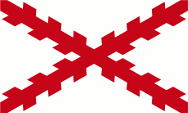 |
1535–1717, Flagge Vize-Königreich Neu-Spanien – flag of the Viceroyalty of New Spain, Quelle/Source, nach/by: Wikipedia (ES) |
 |
1717–1785, Flagge Vize-Königreich Neu-Granada – flag of the Viceroyalty of New Granada, Quelle/Source, nach/by: Wikipedia (EN) |
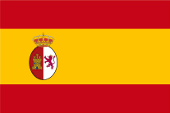 |
1785–1819, Flagge Vize-Königreich Neu-Granada – flag of the Viceroyalty of New Granada, Quelle/Source, nach/by: Wikipedia (EN) |
 |
1777–1824, Flagge des Generalkapitanats Venezuela – flag of the General-Captaincy of Venezuela, Quelle/Source, nach/by: Flags of the World |
 |
1806, Coro, Flagge von Francisco de Miranda in Coro – flag of Francisco de Miranda in Coro, Quelle/Source, nach/by: Wikipedia (ES) |
 |
1810–1811, Flagge der loyalen Junta – flag of the loyal Junta, Quelle/Source, nach/by: Flags of the World, Wikipedia (ES) |
 |
1811, Flagge der Vereinigten Provinzen – flag of the United Provinces, Quelle/Source, nach/by: Wikipedia (ES) |
 |
1811, Flagge von Venezuela – flag of Venezuela, Quelle/Source, nach/by: Wikipedia (ES) |
 |
1812, Flagge von Venezuela – flag of Venezuela, Quelle/Source, nach/by: Wikipedia (ES), using Salvadoroff, CC BY-SA 4.0, via Wikimedia Commons |
 |
1813–1816, Flagge Spaniens – flag of Spain, Quelle/Source, nach/by: Flags of the World |
 |
1817, Flagge von Venezuela – flag of Venezuela, Quelle/Source, nach/by: Wikipedia (ES) |
 |
Mai/May–November 1817, |
 |
1817–1819, National- und Marineflagge – national and naval flag, Quelle/Source, nach/by: Flags of the World, Wikipedia (ES) |
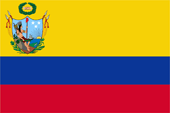 |
1819–1820, Nationalflagge Großkolumbiens – flag of Greater Colombia, Quelle/Source, nach/by: HansenBCN [CC BY-SA 4.0], via Wikimedia Commons |
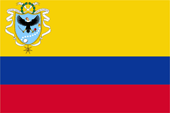 |
1820–1821, Nationalflagge Großkolumbiens – flag of Greater Colombia, Quelle/Source, nach/by: Milenioscuro [CC BY-SA 3.0], via Wikimedia Commons |
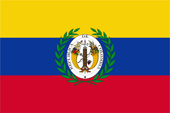 |
1821–1830, Nationalflagge Großkolumbiens – flag of Greater Colombia, Quelle/Source, nach/by: Milenioscuro [CC BY-SA 3.0], via Wikimedia Commons |
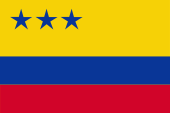 |
1822–1830, |
 |
1830–1836, Nationalflagge von Venezuela – national flag of Venezuela, Quelle/Source, nach/by: Flags of the World, Wikipedia (ES) |
 |
1836–1863, Nationalflagge von Venezuela – national flag of Venezuela, Quelle/Source, nach/by: Flags of the World, Wikipedia (ES) |
 |
1859–1863, |
 |
1863–1905, |
 |
1863–1905, |
 |
1905–1930, |
 |
1905–1930, |
 |
1930–2006, National-, Staats- und Marineflagge – national, state and naval flag, Seitenverhältnis – ratio = 2:3, Quelle/Source, nach/by: Flags of the World, Wikipedia (ES)   |
 |
1930–2006, |
 |
1970er/1970s, Standarte des Präsidenten – standard of the President, Seitenverhältnis – ratio = 1:1, Quelle/Source, nach/by: Flags of the World |
| Die Flagge Venezuelas wurde in der heutigen Form im Jahre 1930 eingeführt und 1954 und 2006 erneut offiziell bestätigt. In ihrer Grundform wurde sie schon 1811 angenommen und seither immer wieder leicht modifiziert, zuletzt am 12.03.2006, mit einer Änderung im Wappen und mit der Änderung der Anzahl der weißen Sterne. Die Flagge zeigt drei horizontale Streifen in Gelb, Blau und Rot. In der Mitte des blauen Streifens befinden sich acht in einem Bogen angeordnete weiße Sterne. Vor 2006 waren es sieben Sterne. Sie standen für die sieben ehemaligen Provinzen welche die Unabhängigkeitserklärung unterzeichneten. Der achte Stern repräsentiert die historisch Provinz Guayana und erinnert an das Dekret von Simón Bolívar vom 20.11.1817, in dem er die Aufnahme eines achten Sterns für Guayana anordnete. Die National-, Staats- und Marineflagge zeigt zusätzlich im gelben Streifen am Mast das Wappen des Staates. Die Farben Gelb, Blau und Rot sollen die Trennung des Landes (Landesfarbe: Gelb) von der Kolonialmacht Spanien (Landesfarbe: Rot) durch das Meer (Blau) symbolisieren. Gelb steht auch für den Reichtum des Landes, für den Sonnenschein und die Kornfelder. Blau steht für den Himmel, den Ozean und die Flüsse, und Rot steht für das für die Unabhängigkeit vergossene Blut. Die Farbkombination geht zurück auf den venezolanischen Freiheitskämpfer Francicso de Miranda (1750–1816). Er verwendete in Jahre 1801 in London erstmalig eine Flagge mit diesen Farben, in der Anordnung Rot-Gelb-Blau. Die Flagge geht in ihre Farben auf Johann Wolfgang von Goethe zurück, der eine eigene Farbenlehre entwickelt hatte und Miranda 1785 in Weimar mit seinen Vorstellungen von Farben und ihren psychologischen Wirkprinzipien aufmerksam machte, und Gelb, Blau und Rot als die hauptsächlich vom Menschen wahrgenommenen Farben beschrieb. Miranda übernahm diese Farben. Häufig wird unterstellt, dass Miranda "Hellblau" gewählt hätte, was auch auf einigen Flaggendarstellungen aus dieser Region und Zeit zu finden ist. Das ist problematisch. Flaggen als historische Fundstücke werden oft mit dem modernen Auge betrachtet, und schnell wird eine bestimmte Farbbezeichnung verwendet. Dabei wird völlig ignoriert, dass das Hellblau auf Auswaschen und Verbleichen zurückzuführen ist, eine bei Indigo (einen anderen Farbstoff gab es damals noch nicht) bis heute bekannte und auch entsprechend ausgenutzte Eigenschaft. Ekuador und Venezuela verwenden ähnliche Flaggen, ein Hinweis auf die einstige historische Vereinigung der Länder Ekuador, Venezuela und Kolumbien innerhalb Großkolumbiens. Das Gebiet des heutigen Venezuela wurde ab 1500 von Spanien kolonisiert, so dass die Flaggen rot-gelben Flaggen Spaniens verwendet wurden, ganz offiziell ab 1535, als das Vizekönigreich Neuspanien, zu dem das heutige Venezuela gehörte, gegründet wurde. Nachdem im Jahre 1477 mit Karl dem Kühnen der letzte Erbe des Hauses Burgund in der Schlacht von Nancy gefallen war, beanspruchte das Haus Habsburg dessen Erbe. Als die Habsburger mit Karl I. im Jahre 1516 in Spanien auf den Thon kamen wurde eine neue Flagge zur Verwendung auf See und in Übersee eingeführt. Sie war weiß und zeigte das rote geastete Diagonalkreuz der Burgunder. Flaggen in Rot und Gelb blieben aber weiterhin in Gebrauch und zeigten ein sehr unterschiedliches Erscheinungsbild, häufig Kreuze aber auch mehrere Streifen. Im Jahre 1777 wurde das Generalkapitanat Venezuela gebildet, das nur noch formell dem Vize-Königreich Neu-Granada unterstand, zu dem das Gebiet von Venezuela seit 1717 gehörte. Das Generalkapitanat Venezuela soll auch eine eigene Flagge gehabt haben, das ist nicht ganz sicher, sie soll ein gelbes Diagonalkreuz auf grünem Grund gezeigt haben. Im Jahre 1785 wurde eine neue spanische Flagge eingeführt. Sie sollte vor allem die spanischen Schiffe auf dem Meer besser kennzeichnen, da es in dieser Zeit viele weiße Flaggen gab. Der Freiheitskämpfer Francisco de Miranda begann 1801 mit der Agitation für den Kampf gegen Spanien und war bemüht sich freiwillige Kämpfer für seine "Columbiano-Armee" anzuwerben. Dabei präsentierte er auch eine Flagge, die drei horizontale Streifen in Rot, Gelb und Blau zeigte. Francisco de Miranda wollte seine militärische Truppe am 28.04.1806 in Ocumare de la Costa an Land setzen, was nach einem Seegefecht misslang. Zwei seiner Schiffe fielen in die Hände der Spanier. Dabei wurde auch eine Flagge in Schwarz, Rot und Gold von den Spaniern erbeutet, welche die Flagge der "Columbiano-Armee" hätte werden sollen. Francisco de Miranda landete dann am 03.08.1806 mit seiner kleinen Truppe in Coro und konnte den Ort einige Tage besetzen. Francisco Labastida, der Diener der Pfarrkirche hat die von Francisco de Miranda mitgeführte Flagge beschrieben, und zwar mit drei Streifen, Blau oben, Gelb in der Mitte, Rot unten. Die im Lande um sich greifende Freiheitsbewegung führte 1808 beinahe zu einem Putsch in Caracas. Weil die Macht Spaniens allmählich ins Wanken geriet, bildete sich in Caracas die "Oberste Konservative Junta der Rechte Ferdinands VII." als Gegenbewegung. Ihr Symbol, vor allem als Armbinde verwendet, waren drei Streifen in Rot, Gelb und Schwarz und im Gelben Streifen waren die Initialen des Königs Ferdinand VII. von Spanien platziert: "FVII". Am 05.07.1811 begann der Unabhängigkeitskampf, die Provinzen Barcelona, Barinas, Caracas, Cumaná, Margarita, Mérida und Trujillo sagten sich von Spanien los und bildeten die "Vereinigten Provinzen von Venezuela". Francisco de Miranda überreichte dem Kongress der Provinzen eine Flagge in Gelb, Blau und Rot. Der Kongress, jetzt Oberster Kongress von Venezuela, nahm am 09.07.1811 als Nationalflagge einen Entwurf von Francisco de Miranda und Lino de Clemente an. Diese Flagge zeigte wieder drei Streifen in Gelb, Blau und Rot, jedoch war der gelbe Streifen doppelt so breit wie die anderen um Platz für eine Allegorie in der Oberecke zu haben. Diese zeigte eine auf einem Felsen sitzende Indianerin mit einem Stab in der Hand auf dem oben eine phrygische Mütze steckt, dazu eine aufgehende Sonne, einen Alligator und verschiedene Früchte, die Aufschrift "Venezuela" und unten ein Band mit dem Wort "Colombia". Am 15.02.1812 wurde die Flagge geändert, die Oberecke zeigte jetzt einen Kondor mit einer stilisierten Sonne auf der Brust, der Pfeile und einen Caduceus in den Krallen hält, darüber ein Spruchband mit dem Motto: "Concordia Res Parve Crescunt" → "Kleine Staaten wachsen durch Eintracht". Zwischen 1813 und 1816 hatte Spanien die Kontrolle über Venezuela zurückerlangt, musste das Land jedoch am 07.05.1816 in die Unabhängigkeit entlassen. Am 12.05.1817 wurde die Flagge von 1811 wieder eingeführt. Da sie aber schwer zu produzieren war, wurde die Flagge zunächst für die Marine im oberen, großen, gelben Feld mit sieben blauen Sternen (stehend für die 7 Provinzen) bestückt, wurde aber auch als Nationalflagge an verwendet. General Simón Bolívar veranlasste am 20.11.1817, nach der erfolgreichen militärischen Guayana-Kampagne, dass ein achter Stern (für Guayana) hinzugefügt wird. Am 17.12.1819 schlossen sich die Vereinigten Provinzen von Neugranada (das spätere Kolumbien) mit den Provinzen Quito (Ekuador) und Venezuela unter der Führung von Simón Bolívar zur Republik Großkolumbien zusammen. Für dieses Land sollte es auch eine neue Flagge geben. Dabei wurden die Farben Gelb, Blau und Rot übernommen und für die Flagge des Landes verwendet, wieder mit dem breiten gelben Streifen, der jetzt in der Oberecke eine Allegorie mit einem sitzenden Indianer zeigte. Schon nach einem Jahr wurde das Wappen geändert, das blaue Schild zeigte jetzt einen Condor und mehrere Sterne. Jedoch waren die Regelungen uneinheitlich und das Wappen umstritten, so das die Flaggen von Kolumbien, Venezuela offiziell weiter verwendet werden durften. Am 04.10.1821 verabschiedete der Generalkongress von Großkolumbien den Beschluss zum Wappen. Es war jetzt eine Art Kartusche, die ein Liktorenbündel und zwei Füllhörner zeigte und ringsum den Namen des Landes. Es war jetzt in der Mitte der Flagge platziert, die nun drei gleich breite Streifen hatte. Dies Flagge wurde bis zum Ende Großkolumbiens im Jahre 1830 beibehalten. Es gab auch Varianten der Flagge, die das Wappen in die Oberecke der vorherigen Flagge platzierten. Die Flagge Großkolumbiens wurde jedoch in der Praxis häufig ohne Wappen verwendet, das Obereck war dann ergänzt um drei blaue Sterne. Diese standen für die drei Landesteile Neugranada, Venezuela und Quito. Sicherlich war diese Flagge wieder leichter herzustellen. Großkolumbien zerfiel 1830 nach dem Tod von Simón Bolívar in die Staaten Neugranada, Venezuela und Ekuador. Venezuela behielt zunächst und provisorisch die Farben der Flagge von Großkolumbien bei und auch das Wappen wurde leicht abgeändert weiterverwendet. 1836 wurde eine neues Wappen für die Vereinigten Staaten von Venezuela angenommen, der heutigen Version schon weitestgehend gleich, das im gelben Streifen in die Oberecke der farblich unveränderten Flagge platziert wurde. 1859 kam es in der Stadt Coro zu einem Putsch und eine Junta verfügte, dass die Flagge der Republik Venezuela vom Mai 1817 wieder als Nationalflagge eingeführt wird. Die darauf folgenden Auseinandersetzungen führten zum Vertrag von Coche, mit dem sich die Junta im Jahre 1863 durchsetzte und es wurde beschlossen, die sieben weißen Sterne von 1817 in der Mitte des blauen Feldes der gelb-blau-roten Flagge zu setzen, sechs Sterne gruppiert um einen mittleren Stern. Im Jahre 1905 wurden auf Anordnung des Präsidenten die Sterne in der Mitte des blauen Feldes in Kreisform angeordnet. Zu einer erneuten Änderung kam es im Jahre 1930, diesmal durch den Kongress, die kreisförmige Anordnung der sieben Sterne wurde aufgehoben und diese stattdessen in einem Halbkreis in der Mitte des blaue Feldes platziert. |
The flag of Venezuela was introduced in its current form in 1930 and
officially confirmed in 1954 and again in 2006. It was adopted in its basic
form in 1811 and has been slightly modified ever since, most recently on
12th of March in 2006 with a change in the coat of arms and the number of white stars. The flag shows three horizontal stripes in yellow, blue and red. In the centre of the blue stripe are eight white stars arranged in an arc. Before 2006 there were seven stars. They stood for the seven former provinces that signed the Declaration of Independence. The eighth star represents the historical province of Guyana and commemorates Simón Bolívar's decree of 20th of November in 1817, in which he ordered the inclusion of an eighth star for Guyana. The national, state and naval flags also show the coat of arms of the state in the upper corner in the yellow stripe on the mast. The colours yellow, blue and red are intended to symbolise the separation of the country (national colour: yellow) from the colonial power Spain (national colour: red) by the sea (blue). Yellow also symbolises the country's wealth, the sunshine and the cornfields. Blue symbolises the sky, the ocean and the rivers, and red stands for the blood shed for independence. The colour combination goes back to the Venezuelan freedom fighter Francicso de Miranda (1750–1816). He used a flag with these colours for the first time in 1801 in London, in the arrangement red-yellow-blue. The colours of the flag can be traced back to Johann Wolfgang von Goethe, who had developed his own colour theory and drew Miranda's attention to his ideas about colours and their psychological principles of action in Weimar in 1785, describing yellow, blue and red as the colours mainly perceived by humans. Miranda adopted these colours. It is often assumed that Miranda chose "light blue", which can also be found on some depictions of flags from this region and time. This is problematic. Flags as historical artefacts are often viewed with a modern eye and a specific colour designation is quickly applied. This completely ignores the fact that the light blue is due to washing out and fading, a property of indigo (there was no other dye at the time) that is still known and exploited today. Ecuador and Venezuela use similar flags, a reference to the former historical union of the countries of Ecuador, Venezuela and Colombia within Greater Colombia. The territory of present-day Venezuela was colonised by Spain from 1500, so that the red and yellow flags of Spain were used, officially from 1535, when the Viceroyalty of New Spain, to which present-day Venezuela belonged, was founded. After Charles the Bold, the last heir to the House of Burgundy, fell in the Battle of Nancy in 1477, the House of Habsburg claimed his inheritance. When the Habsburgs came to power with Charles I. in Spain in 1516, a new flag was introduced for use at sea and overseas. It was white and showed the red diagonal cross of the Burgundians. However, flags in red and yellow remained in use and had a very different appearance, often showing crosses but also several stripes. In 1777, the General Captaincy of Venezuela was formed, which was only formally subordinated to the Viceroyalty of New Granada, to which the territory of Venezuela had belonged since 1717. The Captaincy General of Venezuela is also said to have had its own flag, although this is not entirely certain. It is said to have shown a yellow diagonal cross on a green background. A new Spanish flag was introduced in 1785. Its main purpose was to better identify Spanish ships at sea, as there were many white flags at that time. The freedom fighter Francisco de Miranda began agitating for the fight against Spain in 1801 and endeavoured to recruit volunteers for his "Columbiano Army". He also presented a flag with three horizontal stripes in red, yellow and blue. Francisco de Miranda wanted to debark his military force in Ocumare de la Costa on 28th of April in 1806, but this failed after a sea battle. Two of his ships fell into the hands of the Spanish. The Spaniards also captured a flag in black, red and gold, which should have become the flag of the "Columbiano Army". Francisco de Miranda then landed in Coro on 3rd of August in 1806 with his small force and was able to occupy the town for a few days. Francisco Labastida, the servant of the parish church, described the flag carried by Francisco de Miranda as having three stripes, blue at the top, yellow in the centre and red at the bottom. The freedom movement spreading throughout the country almost led to a coup in Caracas in 1808. As Spain's power gradually began to falter, the "Supreme Conservative Junta of the Rights of Ferdinand VII" was formed in Caracas as a counter-movement. Its symbol, mainly used as an armband, was three stripes in red, yellow and black and the initials of King Ferdinand VII. of Spain were placed in the yellow stripe: "FVII". On 5th of July in 1811, the struggle for independence began and the provinces of Barcelona, Barinas, Caracas, Cumaná, Margarita, Mérida and Trujillo broke away from Spain to form the "United Provinces of Venezuela". Francisco de Miranda presented the Congress of Provinces with a flag in yellow, blue and red. On 9th of July in 1811, the Congress, now the Supreme Congress of Venezuela, adopted a design by Francisco de Miranda and Lino de Clemente as the national flag. This flag again showed three stripes in yellow, blue and red, but the yellow stripe was twice as wide as the others to make room for an allegory in the upper corner. This showed an Indian woman sitting on a rock with a rod in her hand with a Phrygian cap on top, a rising sun, an alligator and various fruits, the inscription "Venezuela" and a ribbon with the word "Colombia" at the bottom. On 15th of February in 1812, the flag was changed, the upper corner now showed a condor with a stylised sun on its chest, holding arrows and a caduceus in its claws, above a banner with the motto: "Concordia Res Parve Crescunt" → "Small states grow through concord". Between 1813 and 1816, Spain regained control of Venezuela, but was forced to grant independence to the country on 7th of May in 1816. On 12th of May in 1817, the flag of 1811 was reintroduced. However, as it was difficult to produce, a flag was initially used for the navy with an upper, large, yellow field with seven blue stars (representing the seven provinces), but was also used as the national flag. On 20th of November in 1817, after the successful military Guyana campaign, General Simón Bolívar ordered that an eighth star (for Guyana) be added. On 17th of December in 1819, the United Provinces of New Granada (later Colombia) merged with the provinces of Quito (Ecuador) and Venezuela under the leadership of Simón Bolívar to form the Republic of Greater Colombia. There was also to be a new flag for this country. The colours yellow, blue and red were adopted and used for the country's flag, again with the broad yellow stripe, which now showed an allegory with a seated Indian in the upper corner. After just one year, the coat of arms was changed, with the blue shield now showing a condor and several stars. However, the regulations were inconsistent and the coat of arms controversial, so that the flags of Colombia and Venezuela could officially continue to be used. On 4th of October in 1821, the General Congress of Greater Colombia passed the resolution on the coat of arms. It was now a kind of cartouche showing a bundle of lictors and two cornucopias and the name of the country around it. It was now placed in the centre of the flag, which now had three stripes of equal width. This flag was retained until the end of Greater Colombia in 1830. There were also variants of the flag that placed the coat of arms in the upper corner of the previous flag. In practice, however, the flag of Greater Colombia was often used without the coat of arms, with three blue stars added to the upper corner. These stood for the three parts of the country: New Granada, Venezuela and Quito. This flag was certainly easier to produce again. After the death of Simón Bolívar in 1830, Greater Colombia split into the states of New Granada, Venezuela and Ecuador. Venezuela initially and provisionally retained the colours of the flag of Greater Colombia and the coat of arms was also used in a slightly modified form. In 1836, a new coat of arms was adopted for the United States of Venezuela, largely similar to the current version, which was placed in the yellow stripe in the upper corner of the unchanged flag. In 1859, there was a coup in the city of Coro and a junta decreed that the flag of the Republic of Venezuela from May 1817 be reintroduced as the national flag. The ensuing disputes led to the Treaty of Coche, with which the junta prevailed in 1863 and it was decided to place the seven white stars of 1817 in middle of the blue field of the yellow-blue-red flag, six stars grouped around a central star. In 1905, by order of the President, the stars were arranged in a circle in the centre of the blue field. Another change was made in 1930, this time by the congress, when the circular arrangement of the seven stars was cancelled and they were instead placed in a semicircle in the centre of the blue field. |
| Quelle/Source: Die Welt der Flaggen, Flaggen Wappen Hymnen, Flaggen und Wappen der Welt, Wikipedia (ES) | |
Wappen – Coat of Arms: |
|
 |
seit/since 2006, Wappen von Venezuela – coat of arms of Venezuela, Quelle/Source, nach/by: Wikipedia (ES), Corel Draw 4 |
historische Wappen – historical Coats of Arms: |
|
 |
1830–1836, Wappen von Venezuela – coat of arms of Venezuela, Quelle/Source, nach/by: Wikipedia (ES), Corel Draw 4 |
 |
1836–1863, Wappen von Venezuela – coat of arms of Venezuela, Quelle/Source, nach/by: Wikipedia (ES), Corel Draw 4 |
 |
1863–1905, Wappen von Venezuela – coat of arms of Venezuela, Quelle/Source, nach/by: Wikipedia (ES), Corel Draw 4 |
 |
1905–1930, Wappen von Venezuela – coat of arms of Venezuela, Quelle/Source, nach/by: Wikipedia (ES), Corel Draw 4 |
 |
1930–1954, Wappen von Venezuela – coat of arms of Venezuela, Quelle/Source, nach/by: Wikipedia (ES), Corel Draw 4 |
 |
1954–2006, Wappen von Venezuela – coat of arms of Venezuela, Quelle/Source, nach/by: Wikipedia (ES), Corel Draw 4 |
| Das Staatswappen wurde 1836 angenommen. Änderungen in Details erfolgten 1863, 1905, 1930, 1954 und zuletzt im Jahre 2006. Das Schild ist halbgespalten und geteilt. Das erste Feld ist rot und zeigt eine goldene Getreidegarbe, das zweite Feld ist golden und zeigt eine allegorische Darstellung aus Säbeln und Flaggen, die untere Hälfte des Schildes ist blau und zeigt ein weißes Wildpferd auf einem grünen Boden. Die Getreidegarbe symbolisiert Einheit und Fruchtbarkeit, Säbel und Flaggen verkörpern Unabhängigkeit und militärische Erfolge, das Wildpferd steht für Freiheit. Oberhalb des Schildes befinden sich zwei Füllhörner. Sie stehen für Wohlstand. Unterhalb des Schildes liegt ein Band in den Landesfarben. Es zeigt seit 1930 den Namen des Landes, die Worte "INDEPENDENCIA" und "FEDERACION" und zwei mal ein Datum, den 19. April 1810 (Unabhängigkeit von Spanien) und den 20. Februar 1859 (Beginn des Bundeskriegs in Venezuela). Zuletzt wurde das Wappen am 12.03.2006 abgeändert, zusammen mit der Flagge. Das Wildpferd, das ursprünglich nach rechts lief und nach links zurückschaute, wurde so gedreht, dass es nach links läuft und blickt. Die Farbe der Schrift auf dem Band underhalb des Wappens wechselte von Silder zu Gold und der Name des Staates wurde von "Republik Venezuela" in "Bolivarische Republik Venezuela" abgeändert. |
The coat of arms of
Venezuela was adopted in 1836. Changes in details were made in 1863, 1905,
1930, 1954 and most recently in 2006. The shield is divided party per fess
and in the upper part party per pale. The first field is red and shows a
golden sheaf of grain, the second field is golden and shows an allegorical
representation of sabres and flags, the lower half of the shield is blue and
shows a white wild horse on a green ground. The sheaf of grain symbolises
unity and fertility, the sabres and flags embody independence and military
success, the wild horse stands for freedom. Above the shield are two
cornucopias. They symbolise prosperity. Below the shield is a ribbon in the
national colours. Since 1930, it has shown the name of the country, the
words "INDEPENDENCIA" and "FEDERACION" and two dates, 19th of April in 1810
(independence from Spain) and 20th of February in 1859 (start of the federal
war in Venezuela). The coat of arms was last changed on 12th of March 2006, together with the flag. The wild horse, which originally ran to the right and looked back to the left, was turned so that it runs and looks to the left. The colour of the inscription on the ribbon below the shield changed from silver to gold and the name of the state was changed from "Republic of Venezuela" to "Bolivarian Republic of Venezuela". |
| Quelle/Source: Die Welt der Flaggen, Flaggen Wappen Hymnen, Flaggen und Wappen der Welt, Wikipedia (ES) | |
Flugzeugkokarde – aircraft roundel: |
|
 |
Flugzeugkokarde – aircraft roundel Quelle/Source: nach/by Wikipedia (EN) |
 |
Flugzeugkokarde für Marineflieger – aircraft roundel for naval aviation Quelle/Source: nach/by Wikipedia (EN) |
| Landkarte – Map: |
|
|
| Zahlen und Fakten – Numbers and Facts: | |
|
|
|
|
|
|
|
|
|
|
|
|
|
|
|
|
|
|
|
Frühzeit/Antike
· Besiedlung durch Aruak, Cariben und andere Indianervölker 1498 · Entdeckung durch den spanischen Seefahrer Christoph Kolumbus 1499 · die Spanier Alonso de Ojeda und Amerigo Vespucci erkunden die Küste und das Landesinnere 1500 · Beginn der Kolonisierung durch Spanien, Herausbildung von drei Kolonien (Venezuela [Coro], Nueva Andalucia [Cumaná] und Trinidad-Orinoco, das Land wird der Verwaltung der Kolonie Santo Domingo unterstellt 1528–1556 · Kaiser Karl V. gibt das Land wegen seiner hohen Schulden dem deutschen Bankhaus Welser als Ausgleich zum Lehen, das Bankhaus war bemüht die Schulden aus dem Land einzutreiben, unter besonderer Mitwirkung einer Landsknechtstruppe unter Ambrosius Alfinger, die Unterdrückung und Ausbeutung nimmt derart überhand, dass der Kaiser das Lehen wieder einzieht 1535 · Bildung des Vizekönigreichs Neuspanien, zu dem das heutige Venezuela gehört 1717 · Bildung des Vizekönigreichs Neugranada, welches die heutigen Staaten Kolumbien, Venezuela, Ekuador und Panama umfasst 1724 · Venezuela wird der Kolonie Santo Domingo angeschlossen 1739 · Venezuela wird dem Vizekönigreichs Neugranada angeschlossen 1742 · Gründung der Provinz Venezuela 1777 · Gründung des Generalkapitanats Venezuela (Venezuela-Coro, Nueva Andalucia, Trinidad-Orinoco, La Grita, Trinidad und Guyana) 1781 · großer anti-spanischer Aufstand 1797 · Großbritannien besetzt Trinidad 1802 · Spanien tritt Trinidad offiziell an Großbritannien ab 1806 · Aufstand unter Francisco de Miranda 1810 · Aufstand unter Simón Bolívar, Absetzung des Vizekönigs, jedoch gegenüber Spanien loyale lokale Regierung 14.07.1811 · Unabhängigkeit 1812 · Spanien erobert das Land zurück 07.05.1816 · erneute Unabhängigkeit 1819 · Proklamation der Republik Großkolumbien (ehemaliges Vizekönigreich Neugranada) 1830 · Venezuela und Ekuador spalten sich durch Bürgerkriege von Großkolumbien ab 1835–ca.1900 · Phase ständiger Putsche und Bürgerkriege 24.10.1830 · Proklamation der Republik Venezuela 03.05.1864 · Neue Verfassung, Vereinigte Staaten von Venezuela 19.04.1953 · Neue Verfassung, Republik Venezuela 1992 · Venezuela wird der drittreichste Staat der Erde 1998 · Wahl des sozialistischen Präsidenten Hugo Chávez, der unter anderem Ungleichheiten im Einkommen der Bevölkerung anprangert 30.12.1999 · Neue Verfassung, Bolivarische Republik Venezuela 2004 · das private Gesundheitswesen wird verstaatlicht 2007 · höhere Bildung wird kostenlos 2009 · Privbatbesitz von Waffen wird verboten 2011 · Beginn des wirtschaftlichen Niedergangs, Ansteigen von Korruption und Misswirtschaft 2013 · Tod von Hugo Chávez, Nicolás Maduro wird Nachfolger 2014 · Oppositionsführer werden inhaftiert 2016 · Lebensmittel- und Arzneimittelmangel 2016/2017 · Versuche von Friedensabkommen zwischen der Regierung und FARC und ELN 2017 · die Verfassung wird außer Kraft gesetzt, reguläre Wahlen finden nicht statt, Wahl einer Verfassunggebenden Versammlung (Asamblea Nacional Constituyente), Entmachung des Parlaments, Inflation, Staatsbankrott 2018 · Präsidentschaftswahl, Fluchtwelle 2020 · Präsidentschaftswahl, Unruhen |
|
early times/ancient times · settlement by Aruak, Carib and other indigenous peoples 1498 · discovery by the Spanish navigator Christopher Columbus 1499 · the Spaniards Alonso de Ojeda and Amerigo Vespucci explore the coast and the interior of the country 1500 · start of colonisation by Spain, formation of three colonies (Venezuela [Coro], Nueva Andalucia [Cumaná] and Trinidad-Orinoco, the country is subordinated under the administration of the Colony of Santo Domingo 1528–1556 · Emperor Charles V. gives the country to the German banking house Welser as a fief due to its high debts; the banking house endeavours to collect the debts from the country, with the special assistance of a troop of lansquenets under Ambrosius Alfinger; the oppression and exploitation gets so out of hand that the emperor confiscates the fief. 1535 · formation of the Viceroyalty of New Spain, to which today's Venezuela belongs 1717 · formation of the Viceroyalty of New Granada, which comprises the present-day states of Colombia, Venezuela, Ecuador and Panama 1724 · Venezuela is annexed to the Colony of Santo Domingo 1739 · Venezuela is annexed to the Viceroyalty of New Granada 1742 · foundation of the province of Venezuela 1777 · foundation of the General Captaincy of Venezuela (Venezuela-Coro, Nueva Andalucia, Trinidad-Orinoco, La Grita, Trinidad and Guyana) 1781 · major anti-Spanish uprising 1797 · United Kingdom occupies Trinidad 1802 · Spain officially cedes Trinidad to United Kingdom 1806 · uprising under Francisco de Miranda 1810 · uprising under Simón Bolívar, deposition of the viceroy, but local government loyal to Spain 14th of July 1811 · independence 1812 · Spain reconquers the country 7th of May 1816 · renewed independence 1819 · proclamation of the Republic of Greater Colombia (former Viceroyalty of New Granada) 1830 · Venezuela and Ecuador secede from Greater Colombia due to civil wars 1835–ca.1900 · phase of constant coups and civil wars 24th of October 1830 · proclamation of the Republic of Venezuela 3rd of May 1864 · New Constitution, United States of Venezuela 19th of April 1953 · New Constitution, Republic of Venezuela 1992 · Venezuela becomes the third richest country in the world 1998 · election of socialist President Hugo Chávez, who denounces inequalities in the population's income, among other things 30th of December 1999 · new constitution, Bolivarian Republic of Venezuela 2004 · the private healthcare system is nationalised 2007 · higher education becomes free 2009 · private ownership of weapons is banned 2011 · start of economic decline, increase in corruption and mismanagement 2013 · death of Hugo Chávez, Nicolás Maduro becomes his successor 2014 · opposition leaders are imprisoned 2016 · food and medicine shortages 2016/2017 · attempts at peace agreements between the government and FARC and ELN 2017 · the constitution is suspended, regular elections are not held, election of a Constituent Assembly (Asamblea Nacional Constituyente), parliament is ousted, inflation, national bankruptcy 2018 · presidential election, wave of refugees 2020 · presidential election, riots |
| Quelle/Source: Atlas zur Geschichte, Wikipedia (D), Discovery '97, World Statesmen, www.express.co.uk |
| Der Name "Venezuela" geht auf den italienischen Seefahrer Amerigo Vespucci zurück, den die Küste in der Nähe des heutigen Coro und die Bauweise der indianischen Dörfer mit ihren Häusern auf Pfählen an die Stadt Venedig erinnerten. Er nannte das Land "Veneciola", "Klein-Venedig". Es wurde aber auch einfach nur "Tierra Firma" (Festland) oder sogar "Castilla del Oro" (goldenes Kastilien) genannt. | The name
"Venezuela" goes back to the Italian navigator Amerigo Vespucci, who
remembers the city of Venice as he saw coast near the today's town of Coro
and the construction of the Indian villages with their houses on stilts. He named the country "Veneciola", "Little Venice". However, it was also just called "Tierra Firma" (mainland) or even "Castilla del Oro" (Golden Castille). |
| Quelle/Source: Handbuch der geographischen Namen, Wikipedia (EN) | |